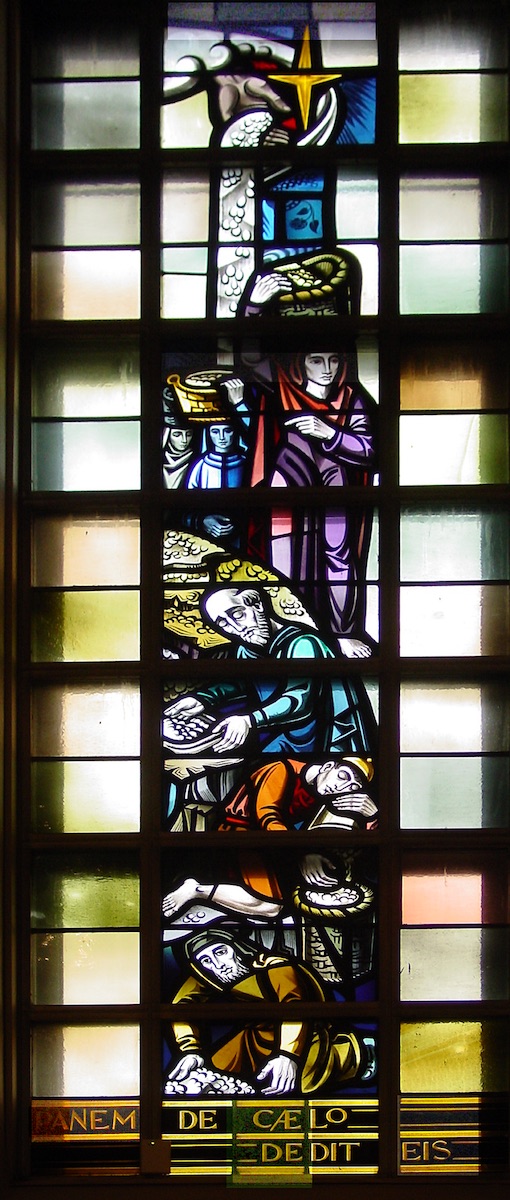


Rebecca Niederlander (b. 1965)
Taproot, 2014
(installation view of Rebecca Niederlander: Axis Mundi, facing west)
polycarbonate sheeting
MOCRA collection, a gift of the artist
About the work
Taproot, consisting of two panels of refractive optical film, is an artistic intervention created by Rebecca Niederlander for her 2014 exhibition at MOCRA, Axis Mundi. By blurring the figural imagery in the windows into flowing colors, she aims to highlight and channel the collective energy of the storytelling element common to all spiritual traditions. As demonstrated by Mircea Eliade, Joseph Campbell and other scholars, certain themes and archetypes emerge repeatedly in the world’s religions, myths, and folklore. Niederlander thus connects the specific Judeo-Christian stories and traditions represented in the windows of the Fusz Memorial chapel, with the broader currents of belief, spirituality, and practice represented by the art displayed at MOCRA.
Most visitors have never seen the ten stained glass windows set in the upper walls of MOCRA’s nave gallery, since they are typically covered for the protection of the artwork on display. The windows were designed and crafted by Rambusch Studios, New York. The north side windows present episodes from the Hebrew scriptures (Old Testament), placed in dialogue with corresponding episodes from the Christian scriptures (New Testament) in the south side windows. Together these pairs served to enrich the education and formation of the Jesuits who lived in Fusz Memorial Hall and worshiped in the chapel.


Above, left (third window, south side):
Colligite quae supera verunt fragmenta ne pereant. / Collect what fragments have been left over, lest they be lost.
(John 6:10–13). Jesus provides for the hungry crowd using only two fish and five barley loaves. There are enough leftovers to fill twelve baskets.
Above, right (third window, north side):
Panem de cælo dedit eis. / He has given them bread from Heaven. (Exodus 16:11–34). In response to the grumbling of the Israelites in the desert, God sends manna from heaven and the Israelites gather it up.
About the artist

Rebecca Niederlander grew up in St. Louis but relocated to Los Angeles in 1995. Her site-specific sculptural installations are labor-intensive abstractions that use repetition and the inherent ephemeral nature of the materials to address the individual’s position within the larger intergenerational community. She is also co-founder of the social practice BROODWORK, in which she curates, writes, speaks and designs actions and objects that explore the interweaving of the creative practices and family life—in particular, parenthood.
The artist speaks
Niederlander notes,
Mary Oliver wrote that “attention is the beginning of devotion.” I find lately that my practice is more and more about being a responsible devotee. Wood, paper, wire, plastic, whatever. Complicated individual elements are brought together precariously; they connect together, stressed by gravity and tension. They are completely responsible for each other. The more precarious the more their own mortality and their response to the stressors of existence mimics our own fleeting moment. I am a materialist in the truest sense of the word. I interrogate these materials lovingly and with great care. It is compulsive, this need for connection. I stand there, with you, be it in person or in spirit. I imagine that we both saw the little place where specs of dust had made a home. I am a spec of dust, as are you, but it is stardust. Every atom in our bodies came from a star that exploded. We are in the middle of our bodies, our families, our communities, the Milky Way.
At its essence: Things fall apart and reconnect. I document it.
More to explore
MOCRA’s “Artful Being” series features brief videos bring together works from the MOCRA collection with music—an invitation to spend a few minutes in stillness and contemplation, to look and listen deeply. This time-lapse video documents the light cycle of a day through the south panel of Taproot.

